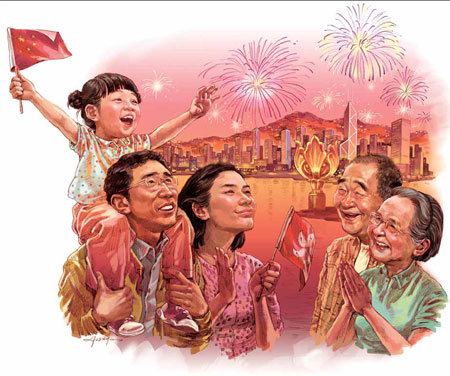
From the inception of the West Kowloon Cultural District to the inscription of intangible cultural heritage on the national list, Hong Kong has made big strides in establishing itself as a global hub for contemporary arts with increased recognition of the city's roots.
Fifteen years after the establishment of the special administrative region, Hong Kong is now set to have a cultural bureau under the incoming administration of Chief Executive-elect Leung Chun-ying.
M+ - the contemporary arts museum - announced on June 12 that Uli Sigg, a well-known collector of contemporary Chinese arts, has decided to donate 1,463 pieces of artworks to the institution.
Sigg, an adviser to the Tate Gallery in London and MoMa in New York, says he has built up a distinguished collection, documenting China's art production "from day one to today - along the timeline, across all media" since the early 1990s.

"By joining forces with M+, the artworks will ultimately come full circle back to China as I have always hoped they would," he says.
The artworks will be put up for permanent display at the museum no earlier than 2017. Sigg says he has chosen a non-existent venue over other established institutions for the city's proximity to the mainland.
M+ -a museum space dedicated to the visual culture of the 20th and 21st centuries - is the centerpiece of the HK$22-billion ($2.84 billion) West Kowloon Cultural District harborfront project.
The ambitious arts hub, due to be completed in two phases, will also consist of 15 performing arts venues and an exhibition center focusing on arts and culture and the creative industry.
It was one of the first major projects unveiled by Hong Kong's first chief executive, Tung Chee-hwa. Delays and controversies have forced the hub's opening to be delayed until the fourth term of the HKSAR administration.
The city's art scene, meanwhile, has continued to evolve as the project stalled.
The Hong Kong International Art Fair was launched in 2008 with 100 galleries. Its fifth edition in 2012 has attracted 266 galleries and more than 60,000 visitors, many of whom are experienced buyers and collectors. An acquisition by Art Basel in 2011 underscored the fair's success in earning its prestige status in the region.
Riding on the eruption of interest in Chinese contemporary arts, Hong Kong has earned its status as the world's third-largest art auction market, behind New York and London. Tax-free arrangements for artworks have been attributed to the exponential growth.
As heavyweight players like Gagosian and White Cube found prime space in the city, workshops of local artists have been struggling with the hike in rents. Oscar Ho Hing-kay, a veteran local curator, expressed his worries in the Fotanian Open Studios' visitors guide in January.
"The government has never spent so much money on culture and arts, but the silence and boredom at the moment is also rare not that nobody is making an effort, but no effort is bearing results," he says.
However, hopes of change are around the corner. All the three candidates in the chief executive election in March had promised to set up a cultural bureau. Leung Chun-ying, who won the election, has included the new bureau in his government restructuring plan.
Florence Hui Hiu-fai, the current under-secretary for home affairs, says the city's cultural policy should be positioned like growing a tree.
"The direction would be what kind of 'cultural tree' we are hoping to grow from this soil. Actually, the deeper the root is, the lusher the leaves would be," Hui said in a television interview. By bringing certain outstanding local activities to the global stage, she believes the city could "grow a forest out of it".
While a full solution for local creators remains to be formulated, Cattle Depot opened in 2001 and the Hong Kong Jockey Club Creative Arts Center, which opened in 2007, have provided some essential relief. More converted industrial space is expected to be offered to the art community for workshops and rehearsals.
As Hong Kong presses ahead in the development of contemporary arts, the city still clings to its cultural roots. The debate on heritage conservation has been focused on the preservation of historical buildings, in particular the Star Ferry Pier and Queen's Pier in Central during 2006 and 2007.
As the government acknowledges the changing expectations of the public, it has also begun dealing with the less obvious.
In June 2011, four of the city's folk rituals and festivals - the Cheung Chau Jiao Festival, the Tai O dragon boat water parade, the Tai Hang fire dragon dance and the Yu Lan Ghost Festival of the Hong Kong Chiu Chow community - were inscribed onto the third national list of intangible cultural heritage.
The application was submitted in 2009 following the inclusion of herbal tea and Cantonese opera onto the first national list.
In a move to meet its obligations under the 2003 Convention for the Safeguarding of the Intangible Heritage, the Hong Kong government has commissioned the South China Research Center at Hong Kong University of Science and Technology to conduct a city-wide survey of intangible cultural heritage.
Liu Tik-sang, head of the survey project, is preparing a final report. "Several hundreds" of rituals, languages and other forms of intangible heritage will finally be included in an official list, subject to final approval by an experts' panel.
The government will formulate measures to safeguard the intangible heritage upon completion of the survey.
kahon@chinadailyhk.com